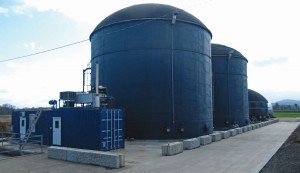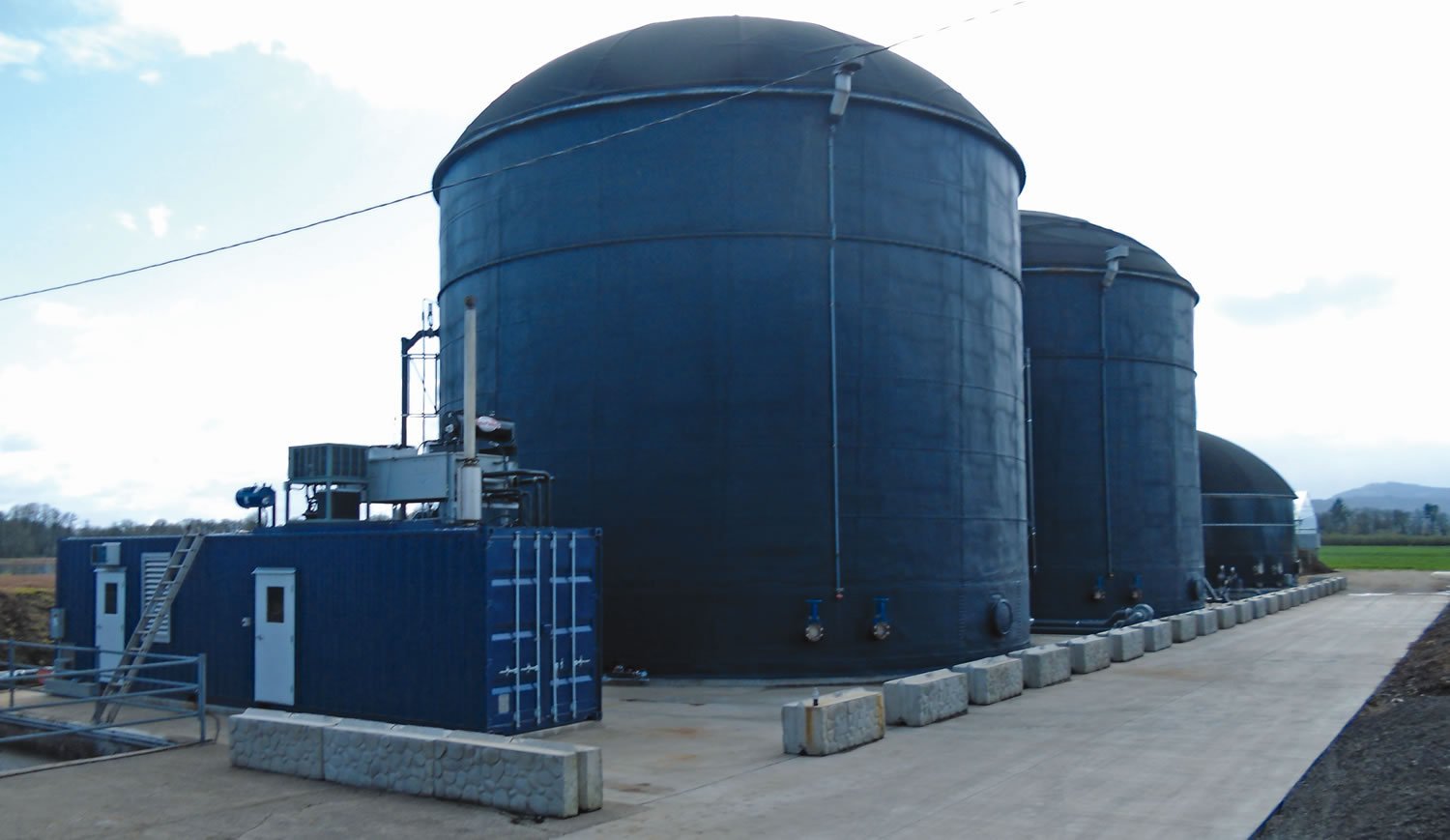In addition to dairy digesters, some operated as codigesters, two projects in development are designed to process source separated food waste streams.
Dan Sullivan
BioCycle March 2012, Vol. 53, No. 3, p. 33

A patented psychrophilic (low temperature) sequential-batch anaerobic digester installed by Revolution Energy Solutions at Lochmead Farms near Junction City, Oregon, processes manure from 750 cows into 1.5 MW of power.
Recently Operational
Lochmead Farms, Inc./Revolution Energy Solutions
“They’re the kind of guys that make changes in American agriculture.” So says Alan Tank of Revolution Energy Solutions, which installed a patented, psychrophilic (low temperature), sequential-batch anaerobic digester on Lochmead Farms, a 3,000-acre, 750-cow dairy operation near Junction City, Oregon, owned by Buzz and Jock Gibson, brothers and third-generation farmers. “We design, build, own and operate,” explains Tank, a managing partner who has been involved in agriculture and food production his whole career. “We understand that every dairy or other livestock farm in the United States already has a complex manure management system that is existing and paid for,” he says, therefore to make AD projects work they must enhance what’s already in place. “We say, ‘We’re going to bring all capital, we want you to bring the feedstock.’ That’s the premise we start with.”
Buzz and Jock Gibson, along with two siblings and seven combined children, bottle and retail their milk out of 44 of their own Dari Mart stores. They grow and distill mint, and raise blueberries and hazelnuts for the ice cream they produce. “One of the motivations for doing the digester is that we sell our milk and ice cream under our own label, and we do the marketing ourselves,” says Jock Gibson. “Being good stewards of the land and dairy come into play when presenting ourselves to the public.”
The digester helps the dairy manage its nutrients and yields digested solids that the farm composts and mixes with sawdust for bedding in its free stalls. Revolution Energy Solutions also provides several revenue streams. It pays Lochmead Farm a percentage of revenue from the sale of approximately 1.5 MW of power to the Emerald People’s Utility District and also a percentage of revenues from carbon funding, a voluntary offset surcharge paid by customers of the local gas utility Northwest Natural. The farm’s combined businesses provide around 500 local jobs.
Solids separated from wastewater at the milk bottling and ice cream plant are sent to the digester at a rate of approximately 1 to 2 percent of total volume. “It’s a very small portion … but our motivation to do that was not so much to create more biogas as to have a way to deal with the waste stream rather than put it into the city sewer system,” says Gibson. “We thought it was more productive to remove it than to pay the city to deal with it.” Lochmead Farm also has a 100 kW solar system attached to its processing plant (and 10 kW systems at 10 of its Dari Marts), grows 80 percent of the hay and corn fed to its cows and eschews the use of hormones to boost milk production. Out in the field, the Gibsons continue to experiment with proper application rates of the nutrient-rich liquid portion of the digestate for different crops. “We’re still getting test results on the digester,” says Gibson. “We have underground irrigation and can put liquid from the lagoon on about 2,000 acres.”
Funding for the $2.2 million project included Oregon’s Business Energy Tax Credit (BETC) program, which can cover up to half of eligible project costs, and federal 1603 Treasury Grant funds, which can cover up to a third of eligible costs. Since some of those “eligible costs” overlap and can’t be funded twice, “you get cut one way or the other,” notes Tank.

Farm Power Rexville in northwestern Washington state is one of five on-farm anaerobic digester projects that brothers Kevin and Daryl Maas have online or on the drawing table in the Pacific Northwest.
Farm Power Northwest, LLC, has five major anaerobic digester (AD) projects online or in the works in the Pacific Northwest. These include Farm Power Rexville and Lynden in Washington State, with Rainier Biogas under construction, and Farm Power Tillamook and Misty Meadow under construction in Oregon. In 2007, brothers Kevin and Daryl Maas founded the company, which uses a community based build-own-operate project development model.
Farm Power Rexville encompasses a 750 kW mixed plug-flow digester served by a total of 1,500 cows on two adjacent farms. Farm Power Linden is similarly configured, only it serves 2,000 cows, and one of the partnering farms heats a 3-acre greenhouse with waste heat from the generator set. Both are codigestion projects that take in food waste. Rainier Biogas near Enumclaw, Washington, was set up to manage the waste of 1,400 cows on four neighboring dairy farms and specifically to capture and export nitrogen and phosphorous out of a sensitive watershed.
“We’ve been careful about making promises about nutrients,” says Kevin Maas, adding that a huge limiting factor in that regard is the amount of land available for nutrient application and for crop rotation. How to cost-effectively recover nutrients, such as nitrogen and phosphorous, in a stable form that could be exported is a question being explored at Rainier Biogas in conjunction with Washington State University, he adds. All the Farm Power projects are contracted to Andgar Corporation utilizing GHD, Inc.’s patented two-stage AD technology. The projects are financed through a variety of funding streams. This includes a Small Company Offering Registration (SCOR) open to the public and support of local lenders such as One Pacific Coast Bank and, more recently, New Resource Bank. Says Maas: “We love the bank financing model, and it’s really come through for us. New Resource Bank is a sustainably-minded bank out of San Francisco and these types of projects are exactly what they want to fund. We’ve driven a lot of risks out of them in a way that bankers can underwrite them.”
In Oregon, Farm Power has been challenged by the power side of the projects. “Because Oregon is a patchwork of utilities, it’s a little more complicated to interconnect there,” he explains. “In Washington we deal with the same utility.” In Oregon, that “patchwork of utilities” is largely supplied by the nonprofit Bonneville Power Administration (BPA), which markets wholesale electrical power from 31 hydro projects in the Columbia River Basin, one nuclear plant and several other power plants. “In general, we’ve got a very professional relationship with Bonneville,” says Maas. “They’re involved in everything we do, because they supply the local PUDs [Public Utility Districts] and serve as their balancing authority. The BPA is ultimately responsible for absorbing the variation introduced to the system by distributed generation like digesters.”
Another challenge in Oregon has been the dropping price point of electricity. About 50 percent of the region’s electricity comes from hydro, and it’s relatively inexpensive. “We moved into Oregon knowing the prices of power [5-6 cents/kWh] were lower than in Washington,” he notes. “That’s why we focused on just these two projects. If we were out there to really push the envelope, I think the falling power prices would have clobbered us.”
Farm Power Tillamook is a 1,000 kW mixed plug-flow digester designed for 1,800 cows on three neighboring farms and is scheduled to begin producing electricity sometime in April 2012. Just a few miles away, Farm Power Misty Meadow represents the third digester project in Tillamook County and the second owned by Farm Power. “Both of these projects are within a mile of downtown Tillamook,” says Maas. “It’s great to be there and great to have the community support the dairy industry. It’s important to us to be in a place where they want dairy farms to stick around … and it’s better for stakeholder engagement.”
Start-Up Phase
Rock Creek Dairy/New EnergyOne, LLC
Three adjacent dairy farms in Filer, Idaho, owned by Bettencourt Dairies and operated under the name Rock Creek Dairy, will supply manure to a new anaerobic digester project being developed by New Energy One, LLC. The project will utilize digester technology from Northern Biogas of Green Bay, Wisconsin, and will be operated under contract with New Energy One by Standley & Co. of Jerome, Idaho. It will treat manure from 8,900 cows. Northern Biogas is supplying six approximately 1 million gallon vessels; five will be used to process the manure and one will be available for experimentation and research.
One test will involve taking digested manure and running it through the experimental tank. “We think that by running it through we can get more energy out,” explains Jay Kesting, Director of Renewable Energy Development for Western States Equipment Co., owners of New Energy One. “We estimate we can generate an extra 200 kW by rerunning it through the digester.” The solids will be used for bedding.
Installed capacity of the project is 3 MW. “We are putting in two Caterpillar G3520 units,” says Kesting, adding that since Western States is a Caterpillar dealer the company was able to use CAT nonrecourse project financing and thereby minimize financial risks. New Energy One has signed a power-purchase agreement with Idaho Power. The project represents the fourth digester in Idaho’s Magic Valley. The first manure was added to the tanks in early February. Initial energy production is scheduled for March and full-scale operation is expected by August 2012.
Heat from the engines is being used to heat the digesters. A chemical separator is being installed for phosporus removal. “Chemical polymers sequester the phosphorus, and it stays with the fiber as opposed to going back to the lagoon,” he explains. “We’re able to pull out about 85 to 90 percent of the phosphorus.” There are currently no plans to process any off-farm organics. “Part of the permit with the county states that any outside organics have to be approved by the county,” Kesting says.
Development And Construction
Columbia Biogas
A $55 million biogas facility on an 11-acre site within the city of Portland, designed to provide 4.2 MW of power at build-out, is on track for an August 2013 startup. “We have our permits with the Oregon Department of Environmental Quality, have a solid waste franchise agreement, air quality permits from the state of Oregon and have had a preapplication meeting with the city of Portland for construction,” explains project engineer Dale Richwine.
A Good Neighbor Agreement with local residents provided a means to incorporate input from the community into the design. The facility will provide up to 15 full-time jobs. In order to secure Section 1603 Treasury Grant funds, Columbia Biogas had to invest at least 5 percent of project costs in order to qualify for “Safe Harbor” before that potential funding stream — for up to 30 percent of eligible costs — expired at the end of 2011. “We actually purchased our tanks last December, and they will be delivered in April to our warehouse,” says Richwine. A final hurdle is securing a guaranteed maximum price (GMP) from the general contractor, hand-in-hand with finalizing financing.
Phase I of the project will involve processing 100,000 tons annually of mixed food waste, industrial solids and liquids from local industry, along with grease trap waste.
“We plan to break ground in June of this year,” he notes. “The site is secured, and we’re moving forward with the final design … It’s been a year of optimizing costs to make the finances work.” A Catch 22 in making such a large-scale metropolitan project go forward, he says, is that financial backers want guaranteed feedstock, and industries that provide that feedstock don’t want to sign contracts more than six months in advance of flipping the switch. Another challenge has been value engineering [balancing maximum function with prudent economics] to control escalating costs.
Columbia Biogas will utilize the Farmatic, Inc. two-stage wet digestion technology. The waste receiving facility is designed to operate under negative pressure to control odors. Waste will be processed within a few hours of receipt and will undergo 1- to 3-days of hydrolysis followed by 30 days of fermentation. The facility expects to process about 40,000 gallons/day of liquid waste in addition to the 100,000 tons/year of solid waste, with tipping fees set between $40 and $60/ton. The facility estimates it will generate 3.2 MW in Phase I.
The biggest challenge fitting a biogas project into an urban setting is to make it cost-effective, says Richwine. “You can’t land apply the digestate, and you have to treat the liquids so they can be discharged to the sanitary sewer.” To tackle both environmental and economic concerns, the project will enlist such technologies as ammonia stripping in order to both create value-added products (e.g., ammonium sulfate and calcium carbonate) and minimize impacts to the local sewer system.
Green Lane Energy
A $13 million bioenergy plant near Junction City, Oregon, will turn waste straw, commercial organics such as vegetable and fruit waste and FOG (fat, oils and grease) collected from the city of Eugene, and livestock manure from area dairies, into 1.6 MW of electricity through anaerobic digestion. Funding for the project includes $2 million from the Energy Trust of Oregon, a nonprofit that channels public-purpose funds collected from ratepayers within the service territory of investor-owned utilities to energy efficiency and renewable energy projects. Funding also included a 1603 Treasury Grant for up to a third of eligible project costs, a 1605 American Recovery and Reinvestment Act grant, a $3 million renewable energy grant from the state of Oregon and a $1.725 million grant from the U.S. Department of Energy. The projected return on investment is 10 years. The project will utilize continuous-stirred reactor wet digester technology supplied by Entec biogas Gmbh and a Caterpillar genset. It is being designed and engineered by ECOregon and Evergreen Engineering, respectively.
The industrially zoned site sits adjacent to 10,000 acres of broad-scale agriculture, mostly grass seed production, says project engineer Dean Foor. All permits are in place and excavating has begun, but construction was stalled due to some initial cost overruns. Concrete work is now scheduled to begin in April. “We have every permit under the sun,” including air, water, solid waste and land use, says Foor. “None were terribly difficult to obtain. We followed the rules, paid the fees and got through it.” The main challenge was dealing with the lack of continuity between the various agencies. “A lot of that stems from the fact that what we are doing is very new and hadn’t been considered when some of these rules were adopted,” he adds.
The 5-acre digester project is also colocated with the 20-acre Lane Forest Products composting facility (the total site is 45 acres), where most of the solids coming out of the digester will be processed. The liquid portion will be land applied to the nitrogen-loving grass seed crops across the street. “All supply and off-take agreements are in place,” says Foor, also commenting on the chicken-and-egg nature of getting feedstock agreements in place prior to project completion. “It’s incredibly painful to build the relationship with folks who supply that material in a way that they believe you are going to accomplish something that hasn’t been done before, and that they should contractually obligate themselves to that.”










